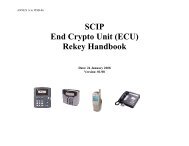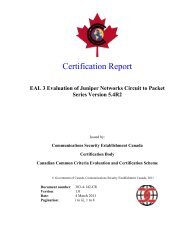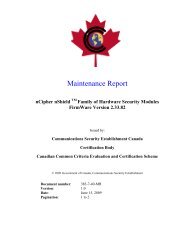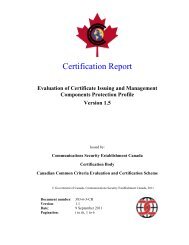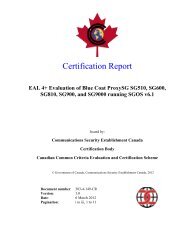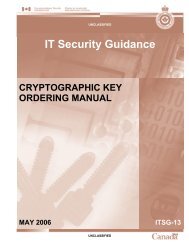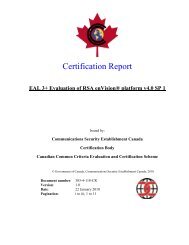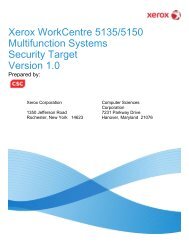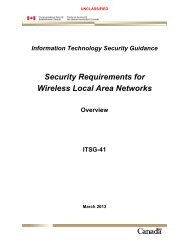Windows Server 2003 Recommended Baseline Security
Windows Server 2003 Recommended Baseline Security
Windows Server 2003 Recommended Baseline Security
You also want an ePaper? Increase the reach of your titles
YUMPU automatically turns print PDFs into web optimized ePapers that Google loves.
Unclassified ITSG for <strong>Windows</strong> <strong>Server</strong> <strong>2003</strong><br />
4.7.4.2 Always prompt client for password upon connection<br />
Computer configuration\Administrative Templates\<strong>Windows</strong> Components\Terminal<br />
Services\Encryption and <strong>Security</strong> \Always prompt client for password upon<br />
connection\=Enabled<br />
The “Always prompt client for password upon connection\=Enabled” setting forces the user to<br />
logon to the local service. This policy enables password challenge upon connection.<br />
4.7.4.3 Report Errors<br />
Computer configuration\Administrative Templates\System\Error Reporting\=Disabled<br />
The “Error Reporting\=Disabled” setting prevents the system from reporting error conditions to<br />
Microsoft.<br />
4.7.4.4 Remove POSIX Subsystem Registry Key<br />
machine\system\currentcontrolset\control\session manager\subsystems\posix<br />
The ‘posix’ value determines if the POSIX subsystem is supported. This policy deletes the key.<br />
This prevents inadvertent use of the subsystem.<br />
4.7.4.5 Set BIOS Password<br />
The system BIOS should be password protected. This follows vendor specific procedures that are<br />
not outlined in this document.<br />
4.7.4.6 Disable Memory Dump<br />
Control Panel/System Properties/Advanced/Startup and Recovery-SettingsWrite Debugging<br />
Information=None<br />
The ability to dump memory in case of a program failure should be disabled. The likelihood of<br />
requiring a memory dump is low, however, if needed you may temporarily enable it.<br />
4.7.4.7 Boot Immediately to <strong>Windows</strong><br />
My Computer/Properties/Advanced/Startup and Recovery-Settings/Time to display list of<br />
operating systems=0<br />
The ‘Time to display list of operating systems’ value determines the number of seconds the<br />
system displays Operating System options at boot time. The setting ‘0’ prevents alternate boot<br />
during normal operations.<br />
4.7.4.8 Disassociate .reg Files from the Registry Editor<br />
1. Start/Settings/Control Panel/Folder Options<br />
2. Select ‘REG’extension<br />
104 March 2004 <strong>Server</strong> Policy Files




